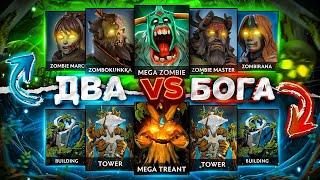
The INCREDIBLE Gods and Goddesses of KOREAN MYTHOLOGY
Комментарии:

It finally arrived 🤩, excellent video 😊👍, it is always a pleasure to watch your videos, they are always entertaining and interesting, Greetings from Paraguay 🇵🇾
Ответить
Great and power beast of time and space
Ответить
한국 신화가 알려지다니!
Ответить
Always wanted to get into Korean mythology. Thank you for this video!
Ответить
I had no idea Korea had this much mythology. Thanks for sharing
Ответить
I want longer videos! ❤
Ответить
From kdrama to kmythology. Love it.
Ответить
Do Vietnamese mythology next
Ответить
Do Vietnam
Ответить
Awesome and cool! ^_^
Ответить
Thank you so much for the video it was very good & filled with quality information.
Ответить
Aaaaaaaah…good to see korean myth getting some light thank you.
Ответить
❤🤍💙 all your videos mate👍
Ответить
Can you do journey to the west day 53
Ответить
Looks at thumbnail. Sees a dragon and a tiger. Sooo they adopted Japanese mythology?
Ответить
I am a descendant of the Korean and Russian diaspora and never knew mythology of my own people. This was amazingly done and had me glued.
It never ceases to amaze me how there are similarities and parallels in various mythologies.

🔥🔥🔥
Ответить
A WIDE old man?
Ответить
Hope you discuss about the
Four Guardian Spirit of Korean mythology
The Snake Turtle
Wooden Dragon
Fire phoenix
White Tiger known as Poongbaek

Korean myths are 100% false. It does not exist. It is a false story created by modern people using Chinese history and mythology.
There is no myth in Japan and Korea. There is no real historical record (only a small number of local indigenous customs recorded by Chinese people).
The so -called history of "Japan and Korea history " are ancient Chinese people who live in ancient Japan Korea.
in today Japan Korea. There are a large number of historical records of local Chinese people, Chinese tombs and Chinese cultural relics.
--------------------------
In the ancient Korea (Chaoxian朝鮮 , Real historical name). It was two different ethnic groups.
1. Chinese (Han Ethnic) - Ruler and nobleman
2. Korean (White Clothes Ethnic) - Civilians and slaves
1. Ruler and nobleman (Goguryeo , Baekje, Silla , Goryeo, Joseon=Chaoxian朝鮮 ..):
Chinese local officials and nobles (royal members, monks, scholars, soldiers, architects, technicians, and their families ...). They are Chinese (Han) and their descendants born in the local area. They have always wore China in China costumes. They speak Chinese language (official and Han dialect) and Chinese characters. They are Chinese officials and represent the Chinese emperor's governance of the ancient Korean Peninsula (朝鮮).
Local Chinese officials (Chaoxian king朝鮮王) and Chinese nobles in ancient Korea (Chaoxian 朝鮮-Chinese territory). They all Chinese clothes (hanfu), headdress (hat and crown), silk cloth (including embroidery), soldiers (such as: defensive clothing, horses). Weapons (including cannons), Chinese literature books (including Chinese history, Taoism Buddhism), Chinese special architectural materials (including palaces and design paintings). Food materials (Chinese food and Chinese royal food), wooden wheels used, large military ships, etc. are made from other cities in China).
Among them, the Chinese royal's (Chaoxian king /officials and nobles) Hanfu comes from Chinese han clothes, opera clothing, and hat crown headwear. Therefore, the fabric on the clothes is high -level. There are a large number of Chinese official dragon patterns and various traditional Chinese patterns (including Chinese characters) on the clothes.
2. Civilians and slaves (Goryeo, Joseon=Chaoxian朝鮮 ..only appeared in history after the 13th century):
Civilians and slaves are indigenous Koreans (White Clothes Ethnic白衣民族). They speak Korean language. Long -term banned learning and use of Chinese characters 漢字(except a few descendants of mixed with Chinese people).
Korean people cannot use any pattern of Chinese imperial power. 龍dragon and 鳯phoenix. In ancient times, this was a beheading and destroyer.
* Chinese patterns and Dragon's totem represents the symbol of the ancient Chinese and Chinese power. Korean people cannot use any pattern of Chinese imperial power. 龍dragon and 鳯phoenix. Only the Chinese royal family and senior officers can use it. If the "White clothes Ethnic 白衣民族" (today's ancestors of Koreans) use the pattern of dragon and use Chinese characters. They will destroy the tribe and beheaded.
Korean characters韓字 are text used by slaves. Ancient Korean can only use Korean characters (after the 15th century. Chinese officials - Chaoxian king and Chinese scholars who settled on the Chaoxian朝鮮 . Chinese officials use Chinese characters and Korean language to create "Korean characters韓字 ".) for slaves.
These low Korean soldiers are used to protect the Chaoxian Peninsula 朝鮮半島(Chinese territory) to prevent Japanese pirates from invasion.
In ancient Korea (Chaoxian朝鮮 ) does not have any technologies and processes such as metal , Bend the wood and dye embroidery patterns.
Most Korean men became low -level soldiers in the Chinese army (under the command of Chinese officers). There is no armor. Korean only wear pure white clothes and korean women's clothing is exposed nipples (Hanbok - Features of traditional Korean clothes).
All Korean women use their heads to move anything (similar to other primitive tribal culture). Korean houses are cottage built with grass (only Chinese can live in Chinese palaces and temples).
Korean people earn food in the market concentrated on exchanging items. They do not have any coins and any metal things. South Korea's national culture and tools for use are very primitive.
Writing history is the tradition and habit of the ancient Chinese.
The history of the ancient Korean Peninsula was written by classical Chinese. This was read for the Chinese and must be approved for the Chinese emperor. This is a record and governance story of Chinese officials and nobles on the ancient Korean Peninsula.
Anceint japan (before 13th century )= 東瀛 & 扶桑 & 倭 . (the name set by the Chinese emperor. It is also the name of the historical record)
Today japan = 日本
Anceint korea= 朝鮮 (and 高包麗. 百濟. 新羅. 王氏高麗. 李氏朝鮮) . (the name set by the Chinese emperor. It is also the name of the historical record)
Today korea = 韓國(南北)
Anceint Nonth Vietnam= 交趾 . (the name set by the Chinese emperor. It is also the name of the historical record)
Today Vietnam = 越南
Anceint Okinawa= 琉球. (the name set by the Chinese emperor. It is also the name of the historical record)
Today Okinawa = 沖繩

HWARANG is a ancient Chinese (Han people). 100% Not Korean.
Hanbok, Koreans clothes showed nipples more than 2000 years(records in the Han Dynasty in China). This is a real Korean national costume.
Historically, Korean women's clothes show their nipples (about 11 years old. After they get married and have children), until they are old, they use their heads to transport things (and the original culture of Africa).
* Ancient Korean traditional costumes are pure white (the Korean people have been known as the "White clothes ethnic" since ancient times), and women's clothes are exposed their nipples (the Korean people show their nipples to represent the beauty). This reflects the ancient Korean people and thoughts.
------------------------------
The historical records of the ancient Korean (Chaoxian朝鮮) are all Chinese characters (the main records of local Chinese officials and noble deeds). This was originally written by the ancient Chinese to the Chinese and future generations. All Korean(Chaoxian朝鮮) historical records needed to be reviewed by the Chinese emperor.
Ancient Koreans Indigenous (Korean ancestors today) lived in ancient Korean (Chaoxian朝鮮) are called "white clothes Ethnic 白衣民族" in historical records.
Westerners have also recorded the fact that the Korean Peninsula(Chaoxian朝鮮) is the Chinese territory (until 1910). Westerners have taken (The facts and photos ) a large number of ancient Koreans (white clothes Ethnic 白衣民族) in white and Korean women 's clothes are exposed nipples (real hanbok in history) and women using their heads to move things.
* Ancient korean (english)= Chaoxian朝鮮 (Chinese territory. This is the name of the Chinese region proposed by the Chinese emperor.)
* Ancient Chaoxian peoples 古代朝鮮人 = Chinese & white clothes Ethnic living on the Korean(Chaoxian) Peninsula.
* Ancient Chaoxian royal and nobles 古代朝鮮皇室和貴族= Chinese
* Ancient Chaoxian Civilians and slaves 代古代朝鮮平民和奴僕= white clothes Ethnic 白衣民族 (Korean ancestors today)
------------------------------
1910. Japan has swallowed Korea. The Japanese believe that some of the low -level Korean traditional culture and primitive (women expose their nipples and transport things on their heads) are very primitive and backward. The Japanese banned Korean women from exposing the nipples (the traditional Korean costume. Hanbok).
The Korean people strongly resisted. Koreans believe that this is a traditional culture of Korea. They insist on retention.
In the Korean capital city. As long as the Japanese see those Korean women who show their nipples, they will give them penalties and slaps. After that, the Korean capital city gradually reduces Korean women's nipples. They cover the nipples with a piece of cloth.
(But in the place where there are fewer Japanese soldiers. Korean women still maintain the traditional culture that exposes nipples).
Until 1950, Westerners were still taking photos in Korea. A photo of Korean women showing nipples on the street (traditional Korean clothing). In 1970, this kind of Korean traditional culture disappeared completely.
------------------------------
Gyeongbok Palace (景福宮) is also a Chinese architecture. It was built by ancient Chinese and Chinese architects on the peninsula. It was part of the ancient Chinese territory and power (before 1900).
"Seoul". The name before 1948 was "Chinese City 漢城".
Anceint japan (before 13th century )= 東瀛 & 扶桑 & 倭 . (the name set by the Chinese emperor. It is also the name of the historical record)
Today japan = 日本
Anceint korea= 朝鮮 (and 高包麗. 百濟. 新羅. 王氏高麗. 李氏朝鮮) . (the name set by the Chinese emperor. It is also the name of the historical record)
Today korea = 韓國(南北)
Anceint Nonth Vietnam= 交趾 . (the name set by the Chinese emperor. It is also the name of the historical record)
Today Vietnam = 越南
Anceint Okinawa= 琉球. (the name set by the Chinese emperor. It is also the name of the historical record)
Today Okinawa = 沖繩

Korea has more variety. Koreans embraced Shamanism, Tengrism, Buddhism, Totemism, and many more. It's really complex when it comes to mythology's origins.
Ответить
Basajaun Don Juan El Negrito en Durango Tepehuan aka Tepeguan ..
Korian/Tepeguan
🧬🩸 Tuatha De Danaan Acacia

His Son is Berserker from Tuatha De Danaan.. Tribe of Yusuf of Kingdom of Yehud ☝️❤️🔥🪽💯🧬🦂🥷🪽
Ответить
Thot and Hathor ..
Ответить
The art is so gorgeous!
Ответить
That was awesome and very interesting. Thank you so much for sharing this!
Ответить
This is a fascinating video! I've always been a fan of mythology! Watching videos like this one has really helped me learn even more about ancient mythology.
Again, this was a very fascinating, and insightful video about Korean mythology! Thank you for posting this wonderful educational video! 🙂❤


























